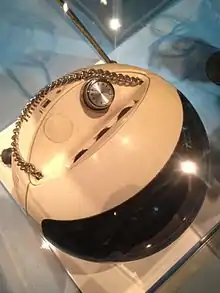Videosphere
Videosphere was a JVC CRT television that was shaped in the form of a space helmet. It was first introduced in 1970 and was sold up until the early-1980s. It was popular for its modern design; the alarm clock base was an option, most units have a plain base.


Videospheres were produced in large quantities in white, red, black and orange in the seventies with a grey colored model also released in the 1980s. The design of the videosphere is said to have been inspired by the film 2001: A Space Odyssey,[1] though the videosphere's shape in itself remains as one of the most iconic examples of the early 1970s design ethos.
The sci-fi look of the TV saw a red model appear as a background prop in the 1999 film The Matrix, though they have appeared in sci-fi films since the early 70s. Soylent Green had a red model on screen as a prop.The 1972 film Conquest of the Planet of the Apes, a black videosphere was shown with a color capable tube and a slot that allowed a cassette tape capable of playing video. Humorously, the color image on the videosphere goes from being rectangular in one scene to round in another scene.
With spare parts becoming an issue for restorers of videospheres, is not uncommon to see spare parts sold on online auctions. Replacement visor screens are particularly sought after.
Video artist Nam June Paik used a white videosphere for his installation TV Buddha in 1974.[2]
References
- JVC Videosphere: What if Flat Panels Never Existed?, Gizmodo, November 29, 2011.
- "Archived copy". Archived from the original on 2012-10-23. Retrieved 2013-02-22.CS1 maint: archived copy as title (link)
- Charlotte & Peter Fiell (2005). Design of the 20th century. Taschen. p. 567. ISBN 3-8228-4078-5.
- Paul Renniel (2003). Miller's 20th Century Design Buyer's Guide. Octopus Publishing Group - Millers. p. 233. ISBN 1-84000-694-3.